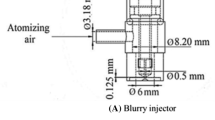Abstract
An experimental investigation of the structure of a kerosene-based Jet A1 unconfined flame is conducted for different fuel flow rates and momentum flux ratios (MFRs). A pressure swirl atomizer is used to atomize the fuel jet. It is found that the flame height increases with increasing MFR for a fixed fuel flow rate. However, the flame height first decreased and then increased with increasing fuel flow rate for a fixed MFR. A correlation of the flame height with the power level and MFR is developed in a dimensionless form by using the response surface optimal design method. Variations in the lean blowout limit with the fuel flow rate are also studied. The lean blowout limit first increases to a peak value and then subsequently decreases, in agreement with the behavior of the flame height at the lean blowout limit. A blue region at the top of the flame is observed for high fuel flow rates. The flame characteristics obtained in the study are explained with the help of the spray characteristics of the kerosene fuel.
Similar content being viewed by others
References
N. A. Chigier and M. F. Roett, “Twin-Fluid Atomizer Spray Combustion,” in ASME Winter Annual Meeting (New York, 1972), Paper No. 79-WA/HT-25.
Y. Onuma and M. Ogasawara, “Studies on the Structure of a Spray Combustion Flame,” in Fifteenth Symp. (Int.) on Combustion (The Combustion Inst., Pittsburgh, 1975), pp. 453–465.
A. M. Mellor, “Workshop on Combustion Measurements in Jet Propulsion Systems,” Project SQUID (Purdue Univ., 1976).
J. E. Usowicz, “An Experimental Study of Flame Lengths and Emissions of Fully-Modulated Diffusion Flames,” M. Sc. Thesis, (Worcester Polytechnic Inst., 2011).
H. A. Becker and D. Hang, “Visible Length of Vertical Free Turbulent Diffusion Flames,” Combust. Flame 32, 115–137 (1978).
T. R. Blake and M. McDonald, “An Examination of Flame Length Data from Vertical Turbulent Diffusion Flames,” Combust. Flame 94, 426–432 (1993).
T. R. Blake and J. B. Cote, “Mass Entrainment, Momentum Flux, and Length of Buoyant Turbulent Gas Diffusion Flames,” Combust. Flame 117 (3), 589–599 (1999).
F. V. Bracco, “Nitric Oxide Formation in Droplet Diffusion Flames,” in Fourteenth Symp. (Int.) on Combustion (The Combustion Inst., Pittsburgh, 1973), pp. 831–842.
A. Williams, “Combustion of Droplets of Liquid Fuels, a Review,” Combust. Flame 21 (132), (1973).
A. M. Mellor, “Simplified Physical Model of Spray Combustion in a Gas Turbine Engine,” Combust. Sci. Technol. 8, 101–109 (1973).
S. K. Aggarwal and W. A. Sirignano, “Ignition of Fuel Sprays Deterministic Calculations for Idealized Droplet Arrays,” in Twentieth Symp. (Int.) on Combustion (The Combustion Inst., Pittsburgh, 1984), pp. 1773–1780.
D. Feikema, R. H. Chen, and J. F. Driscoll, “Enhancement of Flame Blowout Limits by the Use of Swirl,” Combust. Flame 80, 183–195 (1990).
D. Feikema, R. H. Chen, and J. F. Driscoll, “Blowout of Nonpremixed Flames: Maximum Coaxial Air Velocities Achievable, with and without Swirl,” Combust. Flame 86, 347–358 (1991).
R. H. Chen, J. F. Driscoll, J. Kelly, M. Namazian, and R. W. Schefer, “A Comparison of Bluff Body and Swirl Stabilized Flames,” Combust. Sci. Technol. 71, 197–217 (1990).
N. Syred and J. M. Beer, “Combustion in Swirling Flows: A Review,” Combust. Flame 23, 143–201 (1974).
J. M. Beer and N. A. Chigier, Combustion Aerodynamics (Appl. Sci. Publ., London, 1972).
A. H. Lefevbre, Gas Turbine Combustion (Taylor and Francis, 1998).
Weiland N., Chen R. H., and Strakey P. “Effects of Coaxial Air on Nitrogen-Diluted Hydrogen Jet Diffusion Flame Length and NOx Emission,” Proc. Combust. Inst. 33 (2), 2983–2989 (2011).
M. A. Delichatsios, “Transition from Momentum to Buoyancy-Controlled Turbulent Jet Diffusion Flames and Flame Height Relationships,” Combust. Flame 92, 349–364 (1993).
J. S. Shuen, “Prediction of the Structure of Fuel Sprays in Cylindrical Combustion Chambers,” J. Propul. Power 3 (2) (1987).
V. H. Morcos and Y. M. Abdel-Rahim, “Parametric Study of Flame Length Characteristics in Straight and Swirl Light-Fuel Oil Burners,” Fuel 78, 979–985 (1999).
M. Nakamura, D. Nishioka, J. Hayashi, and F. Akamatsu, “Soot Formation, Spray Characteristics, and Structure of Jet Spray Flames under High Pressure,” Combust. Flame 158, 1615–1623 (2011).
K. U. Reddy and D. P. Mishra, “Studies on Spray Behavior of a Pressure Swirl Atomizer in Transition Regime,” J. Propul. Power 24 (1), 74–80 (2008).
S. K. Chen, A. H. Lefebvre, and J. Rollbuhler, “Factors Influencing the Effective Spray Cone Angle of Pressure Swirl Atomizers,” J. Eng. Gas Turb. Power 114, 97–103 (1992).
S. Z. Abghari, J. Towfighi, R. Karimzadeh, and M. Omidkhah, “Application of Response Surface Methodology in Study of the Product Yield Distribution of Thermal Cracking of Atmospheric Gasoil,” Scientia Iranica 15 (4), 457–468.
L. Davies, Efficiency in Research Development, and Production: The Statistical Design and Analysis of Chemical Experiments (The Roy. Soc. Chem., 1993).
M. Rajasimman and K. Murugaiyan, “Sorption of Nickel by Hypnea Valentiae: Application of Response Surface Methodology,” Int. J. Civil Environ. Eng. 3 (1), (2011).
Author information
Authors and Affiliations
Corresponding author
Additional information
Original Russian Text © S.K. Birwa, D.P. Mishra.
Published in Fizika Goreniya i Vzryva, Vol. 51, No. 4, pp. 20–28, July–August, 2015.
Rights and permissions
About this article
Cite this article
Birwa, S.K., Mishra, D.P. Measurements of the visible flame height of a swirl-stabilized kerosene jet diffusion flame. Combust Explos Shock Waves 51, 416–423 (2015). https://doi.org/10.1134/S0010508215040036
Received:
Revised:
Published:
Issue Date:
DOI: https://doi.org/10.1134/S0010508215040036




